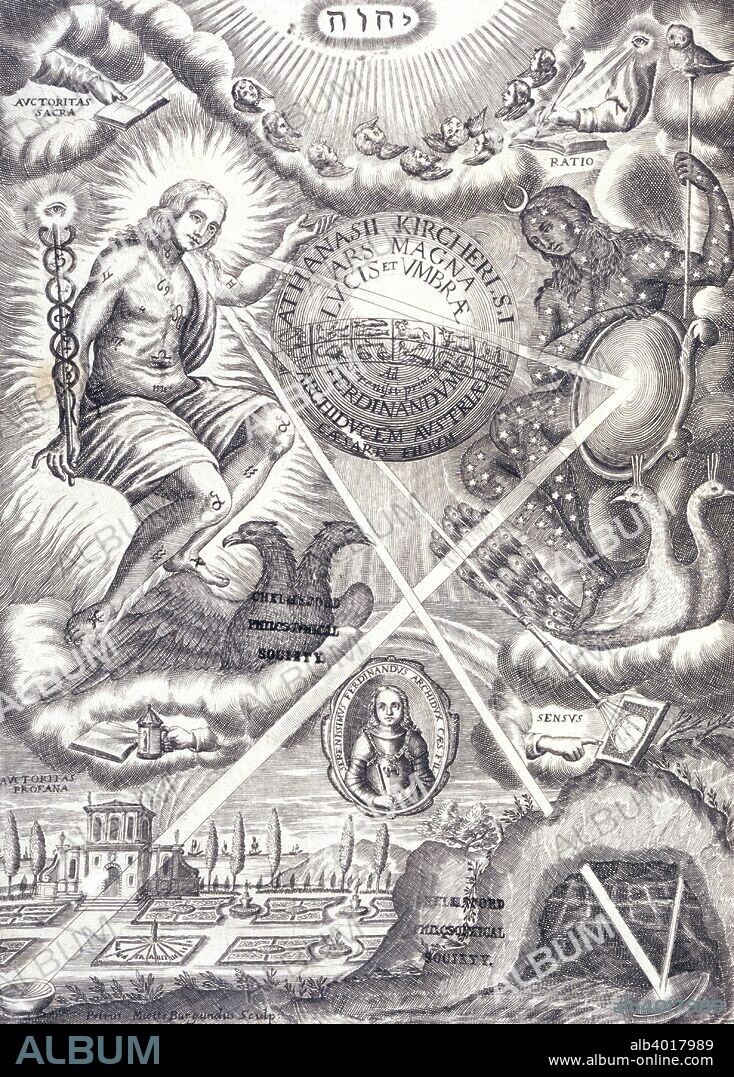alb4017989
Frontispiece from Athanasius Kircher's Ars Magna Lucis Et Umbrae. Artist: Unknown

|
Añadir a otro lightbox |
|
Añadir a otro lightbox |



¿Ya tienes cuenta? Iniciar sesión
¿No tienes cuenta? Regístrate
Compra esta imagen.
Selecciona el uso:

Título:
Frontispiece from Athanasius Kircher's Ars Magna Lucis Et Umbrae. Artist: Unknown
Descripción:
Traducción automática: Frontispicio de Ars Magna Lucis Et Umbrae de Athanasius Kircher. A la izquierda hay una mujer como personificación del sol, con los símbolos del zodíaco cubriendo su cuerpo. A la derecha hay una mujer como personificación de la luna cubierta de estrellas. Debajo de ella se encuentran dos pavos reales. Los rayos de luz inciden en varias lentes, lo que refleja los descubrimientos de Kircher. Kircher demostró que al colocar una lente entre una pantalla y un espejo en el que se había escrito, aparecería en la pantalla una imagen nítida pero invertida del texto. Al utilizar un matraz esférico lleno de agua como condensador para concentrar la luz, Kircher descubrió que los textos pintados en la superficie del espejo podían proyectarse con la luz de una vela después del anochecer. Estas manifestaciones finalmente resultaron en el nacimiento de la linterna mágica. Ars Magna Lucis et Umbrae se publicó en 1646.
Frontispiece from Athanasius Kircher's Ars Magna Lucis Et Umbrae. To the left is a woman as the personification of the sun, with the symbols of the zodiac covering her body. To the right is a woman as a personification of the moon covered in stars. Below her sits two peacocks. Rays of light hit various lenses which reflects Kircher's discoveries. Kircher demonstrated that by placing a lens between a screen and a mirror which had been written on, a sharp but inverted image of the text would appear on the screen. By using a spherical water-filled flask as a condenser to concentrate the light, Kircher found that texts painted on the mirror's surface could be projected by light from a candle after dark. These demonstrations eventually resulted in the birth of the magic lantern. Ars Magna Lucis Et Umbrae was published in 1646.
Crédito:
Album / Oxford Science Archive / Heritage Images
Autorizaciones:
Modelo: No - Propiedad: No
¿Preguntas relacionadas con los derechos?
¿Preguntas relacionadas con los derechos?
Tamaño imagen:
3174 x 4430 px | 40.2 MB
Tamaño impresión:
26.9 x 37.5 cm | 10.6 x 14.8 in (300 dpi)
Palabras clave:
ARTES • ASTROLOGIA • ASTRONOMIA • AVES • BLANCO Y NEGRO • CIENCIA • DAMA • ESTRELLA • FRONTISPICIO • GENTE • LIBRO • LINTERNA MAGICA • LITERATURA • LUNA • LUNAR • MONOCHROME • MONOCROMO • MUJER • MUJERES • PAJARO • PERSONIFICACION • SIGLO XVII • SIGLO • SISTEMA SOLAR • SOL • TEXTO • ZODIACO
 Pinterest
Pinterest Twitter
Twitter Facebook
Facebook Copiar enlace
Copiar enlace Email
Email
